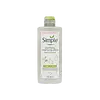What's inside
What's inside
 Key Ingredients
Key Ingredients

 Benefits
Benefits

 Concerns
Concerns

 Ingredients Side-by-side
Ingredients Side-by-side

Water
Skin ConditioningGlycerin
HumectantCetearyl Ethylhexanoate
EmollientCocoglycerides
EmollientDicaprylyl Carbonate
EmollientCetearyl Alcohol
EmollientPanthenol
Skin ConditioningTocopherol
AntioxidantGlyceryl Stearate Citrate
EmollientGlyceryl Stearate
EmollientParfum
MaskingHydroxyacetophenone
AntioxidantAcrylates/C10-30 Alkyl Acrylate Crosspolymer
Emulsion StabilisingXanthan Gum
EmulsifyingPantolactone
HumectantChlorphenesin
AntimicrobialTetrasodium Glutamate Diacetate
Sodium Hydroxide
BufferingWater, Glycerin, Cetearyl Ethylhexanoate, Cocoglycerides, Dicaprylyl Carbonate, Cetearyl Alcohol, Panthenol, Tocopherol, Glyceryl Stearate Citrate, Glyceryl Stearate, Parfum, Hydroxyacetophenone, Acrylates/C10-30 Alkyl Acrylate Crosspolymer, Xanthan Gum, Pantolactone, Chlorphenesin, Tetrasodium Glutamate Diacetate, Sodium Hydroxide
Water
Skin ConditioningHydrogenated Palm Kernel Oil
EmollientGlycerin
HumectantIsopropyl Palmitate
EmollientPolysorbate 60
EmulsifyingSorbitan Stearate
EmulsifyingAcrylates/C10-30 Alkyl Acrylate Crosspolymer
Emulsion StabilisingAllantoin
Skin ConditioningBHT
AntioxidantBisabolol
MaskingCetearyl Alcohol
EmollientDisodium EDTA
Hydroxypropyl Cyclodextrin
MaskingIodopropynyl Butylcarbamate
PreservativePanthenol
Skin ConditioningPantolactone
HumectantPhenoxyethanol
PreservativeSodium Hydroxide
BufferingTocopheryl Acetate
AntioxidantWater, Hydrogenated Palm Kernel Oil, Glycerin, Isopropyl Palmitate, Polysorbate 60, Sorbitan Stearate, Acrylates/C10-30 Alkyl Acrylate Crosspolymer, Allantoin, BHT, Bisabolol, Cetearyl Alcohol, Disodium EDTA, Hydroxypropyl Cyclodextrin, Iodopropynyl Butylcarbamate, Panthenol, Pantolactone, Phenoxyethanol, Sodium Hydroxide, Tocopheryl Acetate
Ingredients Explained
These ingredients are found in both products.
Ingredients higher up in an ingredient list are typically present in a larger amount.
Acrylates/C10-30 Alkyl Acrylate Crosspolymer is a synthetic polymer. It is used to thicken and improve the texture of products. Due to its properties, it can prevent water and oil ingredients from separating.
Cetearyl alcohol is a mixture of two fatty alcohols: cetyl alcohol and stearyl alcohol. It is mainly used as an emulsifier. Emulsifiers help prevent the separation of oils and products. Due to its composition, it can also be used to thicken a product or help create foam.
Cetearyl alcohol is an emollient. Emollients help soothe and hydrate the skin by trapping moisture.
Studies show Cetearyl alcohol is non-toxic and non-irritating. The FDA allows products labeled "alcohol-free" to have fatty alcohols.
This ingredient is usually derived from plant oils such as palm, vegetable, or coconut oils. There is debate on whether this ingredient will cause acne.
Due to the fatty acid base, this ingredient may not be Malassezia folliculitis safe.
Learn more about Cetearyl AlcoholGlycerin is already naturally found in your skin. It helps moisturize and protect your skin.
A study from 2016 found glycerin to be more effective as a humectant than AHAs and hyaluronic acid.
As a humectant, it helps the skin stay hydrated by pulling moisture to your skin. The low molecular weight of glycerin allows it to pull moisture into the deeper layers of your skin.
Hydrated skin improves your skin barrier; Your skin barrier helps protect against irritants and bacteria.
Glycerin has also been found to have antimicrobial and antiviral properties. Due to these properties, glycerin is often used in wound and burn treatments.
In cosmetics, glycerin is usually derived from plants such as soybean or palm. However, it can also be sourced from animals, such as tallow or animal fat.
This ingredient is organic, colorless, odorless, and non-toxic.
Glycerin is the name for this ingredient in American English. British English uses Glycerol/Glycerine.
Learn more about GlycerinPanthenol is a common ingredient that helps hydrate and soothe the skin. It is found naturally in our skin and hair.
There are two forms of panthenol: D and L.
D-panthenol is also known as dexpanthenol. Most cosmetics use dexpanthenol or a mixture of D and L-panthenol.
Panthenol is famous due to its ability to go deeper into the skin's layers. Using this ingredient has numerous pros (and no cons):
Like hyaluronic acid, panthenol is a humectant. Humectants are able to bind and hold large amounts of water to keep skin hydrated.
This ingredient works well for wound healing. It works by increasing tissue in the wound and helps close open wounds.
Once oxidized, panthenol converts to pantothenic acid. Panthothenic acid is found in all living cells.
This ingredient is also referred to as pro-vitamin B5.
Learn more about PanthenolPantolactone is a synthetically created humectant.
As a humectant, Pantolactone helps draw moisture to the skin. It can help add hydration to your skin.
Sodium Hydroxide is also known as lye or caustic soda. It is used to adjust the pH of products; many ingredients require a specific pH to be effective.
In small amounts, sodium hydroxide is considered safe to use. However, large amounts may cause chemical burns due to its high alkaline.
Your skin has a natural pH and acid mantle. This acid mantle helps prevent harmful bacteria from breaking through. The acid mantle also helps keep your skin hydrated.
"Alkaline" refers to a high pH level. A low pH level would be considered acidic.
Learn more about Sodium HydroxideWater. It's the most common cosmetic ingredient of all. You'll usually see it at the top of ingredient lists, meaning that it makes up the largest part of the product.
So why is it so popular? Water most often acts as a solvent - this means that it helps dissolve other ingredients into the formulation.
You'll also recognize water as that liquid we all need to stay alive. If you see this, drink a glass of water. Stay hydrated!
Learn more about Water